
Agardite is a mineral group consisting of agardite-(Y), agardite-(Ce), agardite-(Nd), and agardite-(La). They comprise a group of minerals that are hydrous hydrated arsenates of rare-earth elements (REE) and copper, with the general chemical formula (REE,Ca)Cu6(AsO4)3(OH)6·3H2O. Yttrium, cerium, neodymium, lanthanum, as well as trace to minor amounts of other REEs, are present in their structure. Agardite-(Y) is probably the most often found representative. They form needle-like yellow-green (variably hued) crystals in the hexagonal crystal system. Agardite minerals are a member of the mixite structure group, which has the general chemical formula Cu2+6A(TO4)3(OH)6·3H2O, where A is a REE, Al, Ca, Pb, or Bi, and T is P or As. In addition to the four agardite minerals, the other members of the mixite mineral group are calciopetersite, goudeyite, mixite, petersite-(Ce), petersite-(Y), plumboagardite, and zálesíite.

Zanazziite is a complex hydrated phosphate mineral from the roscherite group. It is a magnesium beryllium phosphate mineral. Zanazziite arises as barrel-shaped crystals and can reach up to 4 mm. It grows alongside quartz minerals. It is found in the crevices of Lavra da Ilha pegmatite, near Taquaral, in northeastern Minas Gerais, Brazil. Zanazziite is named after Pier F. Zanazzi. Zanazziite has an ideal chemical formula of Ca2Mg5Be4(PO4)6(OH)4·6H2O.
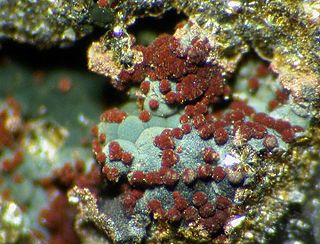
Robertsite, Ca3(Mn3+)4[(OH)3| (PO4)2]2·3(H2O) (alternatively formulated Ca2(Mn3(PO4)3O2)(H2O)3), is a secondary phosphate mineral named for Willard Lincoln Roberts (1923–1987), mineralogist and professor at South Dakota School of Mines in Rapid City, South Dakota.

Aheylite is a rare phosphate mineral with formula (Fe2+Zn)Al6[(OH)4|(PO4)2]2·4(H2O). It occurs as pale blue to pale green triclinic crystal masses. Aheylite was made the newest member of the turquoise group in 1984 by International Mineralogical Association Commission on New Minerals and Mineral Names.

Arthurite is a mineral composed of divalent copper and iron ions in combination with trivalent arsenate, phosphate and sulfate ions with hydrogen and oxygen. Initially discovered by Sir Arthur Russell in 1954 at Hingston Down Consols mine in Calstock, Cornwall, England, arthurite is formed as a resultant mineral in the oxidation region of some copper deposits by the variation of enargite or arsenopyrite. The chemical formula of Arthurite is CuFe23+(AsO4,PO4,SO4)2(O,OH)2·4H2O.
Alsakharovite-Zn (IMA symbol: Ask-Zn) is an extremely rare alkaline strontium zinc titanium silicate mineral from the cyclosilicates class, with the chemical formula NaSrKZn(Ti,Nb)4(Si4O12)2(O,OH)4·7H2O, from alkaline pegmatites. It belongs to the labuntsovite group.

Hureaulite is a manganese phosphate with the formula Mn2+5(PO3OH)2(PO4)2·4H2O. It was discovered in 1825 and named in 1826 for the type locality, Les Hureaux, Saint-Sylvestre, Haute-Vienne, Limousin, France. It is sometimes written as huréaulite, but the IMA does not recommend this for English language text.
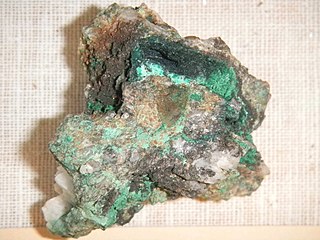
Lipscombite (Fe2+,Mn2+)(Fe3+)2(PO4)2(OH)2 is a green gray, olive green, or black. phosphate-based mineral containing iron, manganese, and iron phosphate.
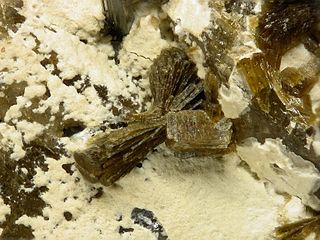
Greifensteinite is beryllium phosphate mineral with formula: Ca2Fe2+5Be4(PO4)6(OH)4·6H2O. It is the Fe2+ dominant member of the roscherite group. It crystallizes in the monoclinic crystal system and typically forms prismatic dark olive green crystals.

Ikranite is a member of the eudialyte group, named after the Shubinov Institute of Crystallography of the Russian Academy of Sciences. It is a cyclosilicate mineral that shows trigonal symmetry with the space group R3m, and is often seen with a pseudo-hexagonal habit. Ikranite appears as translucent and ranges in color from yellow to a brownish yellow. This mineral ranks a 5 on Mohs scale of mineral hardness, though it is considered brittle, exhibiting conchoidal fracture when broken.
Feklichevite is a rare mineral of the eudialyte group with the formula Na11Ca9(Fe3+,Fe2+)2Zr3NbSi(Si3O9)2(Si9O27)2. The original formula was extended to show the presence of cyclic silicate groups and presence of silicon at the M4 site, according to the nomenclature of eudialyte group. When compared to other minerals of the group, feklichevite characterizes in the presence of ferric iron (thus similar to ikranite, mogovidite and fengchengite) and dominance of calcium at the N4 site. Calcium is ordered in the structure and is also present at the M1 site. Other iron-bearing minerals of the group are eudialyte, ferrokentbrooksite, georgbarsanovite, khomyakovite, labyrinthite, oneillite and rastsvetaevite, but they rather contain ferrous iron Feklichevite name honors Russian mineralogist and crystallographer, V. G. Feklichev.
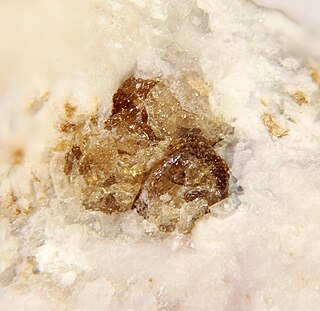
Golyshevite is a rare mineral of the eudialyte group, with the formula Na10Ca3Ca6Zr3Fe2SiNb(Si3O9)2(Si9O27)2CO3(OH)3•H2O. The original formula was extended to show both the presence of cyclic silicate groups and silicon at the M4 site, according to the nomenclature of the eudialyte group. The characteristic feature of golyshevite is calcium-rich composition, with calcium at two main sites instead of one site. Together with feklichevite, fengchengite, ikranite and mogovidite it is a ferric-iron-dominant representative of the group. It is chemically similar to mogovidite. Golyshevite was named after Russian crystallographer Vladimir Mikhailovich Golyshev.
Mogovidite is a very rare mineral of the eudialyte group, with formula Na9(Ca,Na)6Ca6(Fe3+,Fe2+)2Zr3[]Si(Si9O27)2(Si3O9)2(CO3)(OH,H2O)4. The formula given is based on the original one but extended to show the presence of cyclic silicate groups. It is similar to feklichevite, differing from it in the presence of essential vacancies and carbonate group. Another specific feature is the dominance of ferric iron – a feature shared with other eudialyte-group members, including feklichevite, fengchengite, golyshevite and ikranite. Similarly to golyshevite, it is calcium-dominant, however on three sites: M(1), N(3) and N(4). It has a molecular mass of 3,066.24 gm.
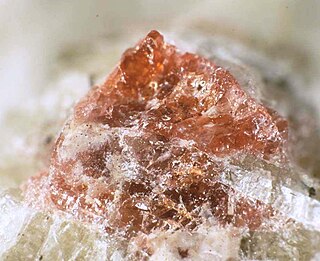
Raslakite is a rare mineral of the eudialyte group with the chemical formula Na15Ca3Fe3(Na,Zr)3Zr3(Si,Nb)SiO(Si9O27)2(Si3O9)2(OH,H2O)3(Cl,OH). This formula is based on the original one, and is extended to show the presence of cyclic silicate groups. The additional silicon and oxygen shown in separation from the cyclic groups are in fact connected with two 9-fold rings. The mineral has lowered symmetry, similarly to some other eudialyte-group members: aqualite, labyrinthite, oneillite and voronkovite. The specific feature of raslakite is, among others, the presence of sodium and zirconium at the M2 site. Raslakite was named after Raslak Cirques located nearby the type locality.

Chanabayaite is the first recognized triazolate mineral, having the formula Cu
2(N
3C
2H
2Cl
4.
Dachiardite-K is a rare zeolite-group mineral with the formula K4(Si20Al4O48)•13H2O. It is the potassium-analogue of dachiardite-Ca and dachiardite-Na, as suggested by the suffix "-K".

Strunzite (Mn2+Fe3+2(PO4)2(OH)2{{·}}6H2O) is a light yellow mineral of the strunzite group, first discovered in 1957.
The sulfate fluorides are double salts that contain both sulfate and fluoride anions. They are in the class of mixed anion compounds. Some of these minerals are deposited in fumaroles.
Zincoberaunite is an iron and zinc phosphate mineral, the Zn analogue of beraunite. It was first described by Chukanov et al. for an occurrence in Hagendorf Sud pegmatite in Germany. Zincoberaunite occurs as a secondary mineral as an alteration product of primary phosphate minerals in granite pegmatites.













